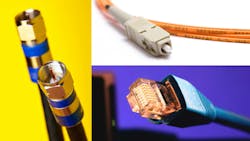Everything Ethernet Everywhere
What you’ll learn:
- What are some of the latest Ethernet options.
- Why developers need to know about these options.
Ethernet has a long history, first appearing in 1973 when I started college. Robert Metcalfe and David Boggs were the main movers and shakers. Since then, Ethernet has emerged as the major networking system covering the cloud, the internet backbone, down to the office and home. It has even invaded cars and the industrial complex.
Last year marked the 50th anniversary of Ethernet although the IEEE 802.3 standard came about 10 years later. The standards built around and atop IEEE 802.3 are numerous and have made interoperability across networks practical. My article, "Ubiquitous Ethernet and Its Many Protocols," takes a deeper look into the wide variety of protocols and standards like time-sensitive networking (TSN) and single-pair Ethernet (SPE).
TSN, like the ubiquitous TCP/IP, isn’t part of the Ethernet standard, but runs atop Ethernet as well as other network transports from Wi-Fi to Thread. Combined, Ethernet and the host of higher-level protocols have made our network-centric environment possible.
The range of Ethernet’s impact can be seen by looking at the latest set of changes regarding SPE, which is being used in cars and industrial applications and even drones. It’s replacing older networking systems like CAN that were synonymous with automotive networking. Part of this is due to lower-cost Ethernet support built into most medium to high-end system-on-chips (SoCs), to the increasing bandwidth requirements for things like cameras, radar, and LiDAR found on today’s vehicles.
Today’s cloud servers are pushing the other end of Ethernet’s throughput. They utilize connections that run at speeds of 800 Gb/s and higher, which requires fiber optic cabling—a far cry from the original coax cable running at 10 Mb/s. These big pipes are needed to link the artificial-intelligence tools running in the cloud to the billions of sensors around the world.
I find it interesting that even as Ethernet moves into the terabit-per-second realm, new standards like 10BASE-T1S bring short-haul Ethernet into embedded applications. Speed is less important than compatibility.
And don’t forget power-over-Ethernet (PoE). This pumps power over the same communication cable, so devices don’t need a separate power source. The latest standard can deliver 90 W.
Our "The Voices of Ethernet" series highlights video interviews conducted by the Ethernet Alliance with the likes of Robert Metcalfe, who have had a significant impact on Ethernet and its adoption over the years.
Will Ethernet continue onward and evolve over the next 50 years? Probably, but where it winds up and what new attributes may be added is anyone’s guess. I hope to find out.
In the meantime, it’s time for me to check out SPE with PoE support on a micro platform talking to a cloud server that’s probably supported by multiple 800-Gb/s Ethernet ports.
About the Author
William G. Wong
Senior Content Director - Electronic Design and Microwaves & RF
I am Editor of Electronic Design focusing on embedded, software, and systems. As Senior Content Director, I also manage Microwaves & RF and I work with a great team of editors to provide engineers, programmers, developers and technical managers with interesting and useful articles and videos on a regular basis. Check out our free newsletters to see the latest content.
You can send press releases for new products for possible coverage on the website. I am also interested in receiving contributed articles for publishing on our website. Use our template and send to me along with a signed release form.
Check out my blog, AltEmbedded on Electronic Design, as well as his latest articles on this site that are listed below.
You can visit my social media via these links:
- AltEmbedded on Electronic Design
- Bill Wong on Facebook
- @AltEmbedded on Twitter
- Bill Wong on LinkedIn
I earned a Bachelor of Electrical Engineering at the Georgia Institute of Technology and a Masters in Computer Science from Rutgers University. I still do a bit of programming using everything from C and C++ to Rust and Ada/SPARK. I do a bit of PHP programming for Drupal websites. I have posted a few Drupal modules.
I still get a hand on software and electronic hardware. Some of this can be found on our Kit Close-Up video series. You can also see me on many of our TechXchange Talk videos. I am interested in a range of projects from robotics to artificial intelligence.

